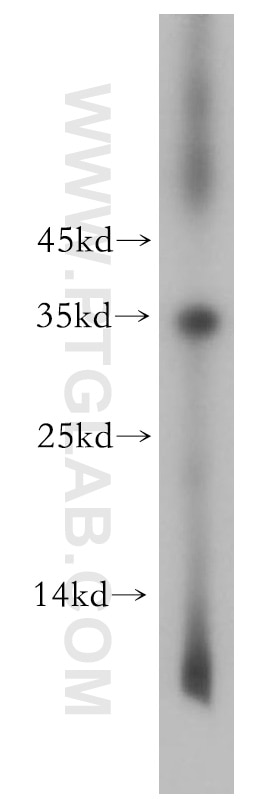Tested Applications
| Positive WB detected in | mouse skeletal muscle tissue, human skeletal muscle tissue |
Recommended dilution
| Application | Dilution |
|---|---|
| Western Blot (WB) | WB : 1:1000-1:4000 |
| It is recommended that this reagent should be titrated in each testing system to obtain optimal results. | |
| Sample-dependent, Check data in validation data gallery. | |
Published Applications
| WB | See 4 publications below |
Product Information
15893-1-AP targets TNNT1 in WB, ELISA applications and shows reactivity with human, mouse, rat samples.
| Tested Reactivity | human, mouse, rat |
| Cited Reactivity | human, mouse, chicken |
| Host / Isotype | Rabbit / IgG |
| Class | Polyclonal |
| Type | Antibody |
| Immunogen |
CatNo: Ag8702 Product name: Recombinant human TNNT1 protein Source: e coli.-derived, PGEX-4T Tag: GST Domain: 46-297 aa of BC022086 Sequence: RMSDTEEQEYEEEQPEEEAAEEEEEEEERPKPSRPVVPPLIPPKIPEGERVDFDDIHRKRMEKDLLELQTLIDVHFEQRKKEEEELVALKERIERRRSERAEQQRFRTEKERERQAKLAEEKMRKEEEEAKKRAEDDAKKKKVLSNMGAHFGGYLVKAEQKRGKRQTGREMKVRILSERKKPLDIDYMGEEQLREKAQELSDWIHQLESEKFDLMAKLKQQKYEINVLYNRISHAQKFRKGAGKGRVGGRWK Predict reactive species |
| Full Name | troponin T type 1 (skeletal, slow) |
| Calculated Molecular Weight | 252aa,27 kDa; 192aa,21 kDa |
| Observed Molecular Weight | 30-35 kDa |
| GenBank Accession Number | BC022086 |
| Gene Symbol | TNNT1 |
| Gene ID (NCBI) | 7138 |
| RRID | AB_2240819 |
| Conjugate | Unconjugated |
| Form | Liquid |
| Purification Method | Antigen affinity purification |
| UNIPROT ID | P13805 |
| Storage Buffer | PBS with 0.02% sodium azide and 50% glycerol, pH 7.3. |
| Storage Conditions | Store at -20°C. Stable for one year after shipment. Aliquoting is unnecessary for -20oC storage. 20ul sizes contain 0.1% BSA. |
Protocols
| Product Specific Protocols | |
|---|---|
| WB protocol for TNNT1 antibody 15893-1-AP | Download protocol |
| Standard Protocols | |
|---|---|
| Click here to view our Standard Protocols |
Publications
| Species | Application | Title |
|---|---|---|
J Muscle Res Cell Motil Differential regulation of Actn2 and Actn3 expression during unfolded protein response in C2C12 myotubes. | ||
J Integr Med Strychni Semen and its active compounds promote axon regeneration following peripheral nerve injury by suppressing myeloperoxidase in the dorsal root ganglia | ||
Food Chem New perspective for Calpain-Mediated regulation of meat Quality: Unveiling the impact on mitochondrial pathway apoptosis in post-mortem |






